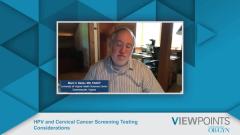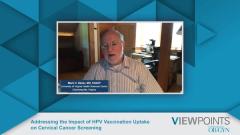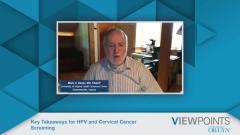
Awareness and Outreach for Cervical Cancer Screening
Drs Mark H. Stoler, Emily K. Hill, Sangini S. Sheth, and Thomas C. Wright comment on the general awareness around HPV and cervical cancer in patients as well as the importance of increasing routine cervical cancer screening approaching those conversations with patients.
Episodes in this series

Dr Thomas C Wright Jr: Dr Hill, how would you characterize the general awareness around HPV and cervical cancer in patients?
Dr Emily K. Hill: Unfortunately, I think it's quite poor. I can speak anecdotally from my practice and, of course, I'm usually often seeing patients with either high-grade dysplasia or cancer and almost always try to have a conversation with why they got the cancer that they have if it's cervical cancer and talk about HPV. I can tell you that a good number of my patients do not recognize that HPV is what causes cervical cancer or what led to their cancer until we talk about it in the office. I think if you're looking at statistics, there are some studies that suggest that maybe only 50% to 60% of people have heard of HPV or understand that HPV is a cancer-causing virus. Then I think there's also a lot of lack of understanding about the types of cancers it can cause. Some people might be aware that it could cause cervical cancer, but don't know about some of the other genital cancers it can cause or oropharyngeal cancers. I think there is a big lack of awareness in the United States about HPV.
Dr Thomas C Wright Jr: Dr Sheth, do you know of approaches which are being taken to increase awareness around HPV, especially in minority groups, transgenders, and various targeted groups?
Dr Sangini S. Sheth: I think a lot of that work can start even among individual clinicians. A lot of times we talk about doing a pap [smeer] or doing cervical cancer screening, but we're often not being very explicit about the role of HPV testing. Having a more explicit conversation that really what we are testing for is the HPV virus can help to connect those dots that it is that virus [HPV] that is causing the dysplasia or the cancer. The more there is outreach to improve cancer screening rates, any of those outreach efforts can also help to connect the dots of that it is, again, the virus that's causing the cervical cancer.
Dr Thomas C Wright Jr: With respect to specific groups of women who aren't being reached, what sort of outreach attempts are being made?
Dr Sangini S. Sheth: Oftentimes we can work on reminder recall systems, so inviting people in to be screened to more proactive approaches instead of waiting for them to show up in the office and leveraging electronic medical record systems to be able to identify people who haven't been screened recently and inviting them back in. I know that there is a lot of hope that we will eventually be able to have an FDA-approved test for self-screening which would also help to improve outreach and otherwise under screened or hard to reach populations. As of right now, we don't have an FDA-approved test for home testing or self-swabbing in the United States.
Dr Thomas C Wright Jr: Dr Stoler, you're at the cutting edge of screening technology. What's the status of self-testing in the United States?
Dr Mark H. Stoler: There's a clinical trial going on that's been slow in getting started. The groups involved include sort of your ideal situation. Several manufacturers cooperating with the government to have internal US data supporting what has been pretty widely published outside of the United States that self-collected HPV testing. We're not talking about self-collected pap smears but the ability to self-collect the sample, ship it dry in the mail to a lab, and then have HPV testing done shows sensitivity and performance characteristics very similar to office collections, which means many women in some countries, as many as 25% or 30% of the women even in an organized program, won't come in but will still be amenable to potentially doing a self-collection at home. I think we're going to see an approval for self-collection from the FDA within the next year or 2, I would hope, because everybody's talking about it as a way to really improve reaching women who otherwise wouldn't be screened. We should all emphasize that in the US, at least, the majority of patients who get cervical cancer are women who haven't been screened. You need to get screened somehow to prevent cervical cancer, to find that precancerous lesion you alluded to, to treat it, to prevent the development of cancer. Nobody dies of pre-cancer. They die of invasive cancer.
Dr Thomas C Wright Jr: We're going to talk in a minute about the different screening approaches, but before we talk about the actual approaches, it would be good if we could discuss how you actually discuss with an individual patient what screening method you're going to use. Dr Hill, how do you discuss this with patients whether or not you're going to do primary screening with HPV or cytology or a combination?
Dr Emily K. Hill: That's a good question. Some of it, we may talk about this more in a minute but has to do with what's available at your institution. At my institution, primary HPV screening is not an option right now, so in my case that's not something I can really offer my patients. I think this is true for a lot of providers in the US. While it is a perfectly acceptable and, in some cases, preferred approach, that's not something that I have available to me. Then my options are cytology alone which I think has been clearly shown to be inferior versus cytology and HPV co-testing. That's the method I usually employ. I will say there's probably not a ton of patient autonomy in that decision-making, at least, in my clinic since that's really the main acceptable option that I have. Then I usually try to explain to patients those 2 components, that there's the cytology, which is looking at the cells on their cervix and looking for abnormalities that might trigger us to be concerned about precancer, but then followed by this or in conjunction with this HPV test, which is trying to identify if their cervix carries HPV because that is certainly the primary risk factor that's going to potentially put them at risk for cervical dysplasia. That's usually how I go about it again, unfortunately not a lot of choice in what approach I take so I tend to more just explain to them the standard approach that I use. I tend to use ASCCP guidelines, although, there are other guidelines that are certainly acceptable.
Dr Thomas C Wright Jr: Dr Sheth, do you have anything to add to that?
Dr Sangini S. Sheth: I would echo what Dr Hill just said that at the current state where it's driven mostly by what is available to us, I would add that I think there's benefit in a practice having an approach because otherwise there will be conflicting strategies that will then result in conflicting follow up and management. Oftentimes I think it's a practice-level approach to what screening tests are available to our patients.
Dr Thomas C Wright Jr: Basically in the United States, HPV together with cytology is used almost universally. Probably over 80% of women who are 30 years and older are screened using the 2 tests in combination, and over 90% of ASCUS gets a reflex HPV test. We really have reached across the country a pretty wide acceptance among clinicians of how they're going to screen.
TRANSCRIPT EDITED FOR CLARITY
Newsletter
Get the latest clinical updates, case studies, and expert commentary in obstetric and gynecologic care. Sign up now to stay informed.



















